Where our hyper-media really should go! Ted Nelson. 1.* - unedited transcript - When we speak of evolution, we don't necessarily mean cooperation. We don't necessarily mean an enjoyable and nice process. Nature remember is red in tooth and claw. The result of evolution may be wondrously integrated, charming, and beautiful. Those parties along the way who participated may not have a very good time. It is not my job to be cooperative. It is not my job to try to find common threads in what we are all doing. It is my job to be the conscience of what we should be doing. Because I believe that everything it totally hopelessly ghastly, and wrong and that we have to basically start over. Let us consider the prevailing paradigm of computers. The so-called computer literacy. The beginners are told oh they come so innocently. I am going to break it. I am so afraid of this. I am not computer literate. So, they learn that we have these operating systems that must be approached in a certain way. Then we have gooeys, which are, of course, very different between the Macintosh, PC, and X Windows. We must to learn to use files, and name them correctly, of course with different sets of rules. Then once we understand those things, we learn about application. Of course, the basic applications are Word Processing, Spreadsheet, and Database. The way we move things back and forth between these things is by the so called clip board which allows us to cut and paste, and copy. I believe this paradigm. Of course, you see paradigms tend to be invisible. You only see paradigms, as a rule, in contrast to other paradigms at which point you get a stereo view. You see a difference image and you say wait a minute something is wrong here. This paradigm, I consider it an abomination. It must be swept away because it is at the heart of everything that is wrong with what people try to do with computers. Every beginner is absolutely correct in saying I don't like this. For very good reasons. I just visited Norway, and a cousin of mine said I won't use computers because you can't see the previous version of what you are working. I said exactly. The beginners know something the experts don't. They have not be steeped. They have not been pickled long enough in what we think of as the solution. Now the problem with paradigms. There are many interesting things about paradigms. I could go on forever. I am trying to stop using the term, and say idea fields. Paradigms are big ideas that are essentially invisible. A soup in which we don't discern. Where we could really have smaller idea fields. Really it is fractal. Little idea fields and big idea fields are the same except they come in all sizes. The great problem is that you can not express one paradigm in terms of another. People say to me why can't you express that in terms that I can understand. If you understood the term, you would understand the paradigm. Unless you can walk through the door into the new ideas, which can not possibly be expressed in your words, there is no hope for communication. Everything that can be done with frankfurters cheese and pickles, has been done. When innocent people ask me well Word Processing, Data Base, and Spreadsheet, that's basic right. It is like trying to explain cuisine to somebody, the concept of cuisine, to someone who has only eaten at McDonalds. They say cuisine. What could it possibly be? You put the fries in the shake, or you put the shake and the fries and the burger next to each other. Or possibly, you put the fries in your nose, put the burger on your head, and pour the shake all over you. These are the possibilities, but there are other possibilities that don't involve the fries, the burger, and the shake, and for that you have to get out of the burger, shake paradigm. That can be very difficult. You can not express one paradigm in terms of another. There is no neutral terminology. Every terminology set is tinged. Now you could, for example, program lisp under mathematica. You would then be working in a mathematics environment, in which your lisp functions would be working. You could program mathematica under lisp, then you would basically be working in a lisp environment. Which one is at the center, is at the top, and determines the flavor of the whole. It is like ordering a steak at a fish restaurant, you will get kind of a fishy steak. The point is that what every is at the center, effects the rest. Computer religions take on their compelling quality, because we all know viscerally, that which ever is at the center, will determine the character of the whole. I think of this as undermining. In the computer world it is always said, well you can implement yours under mine. What that means is yes, it will have the flavor of what I want, but it would really be your system after all. This is very similar to the issue of making a movie. I started as a moviemaker. I made on film before the one that Doug referred to. It spoiled me for life. I believe that software design especially the design of interactive software, is literally a branch of filmmaking. No body has discovered that yet. Movies are events on a screen that affect the heart and mind of the viewer. Inter-active software are events on a screen that affect the heart and mind of the viewer, and interact. Also, they may have some side effect in terms of data. The interaction with the heart and mind may very well be the primary. This is the reason that video games are so much better made than office software. Video games are created by people who want to play video games and office software is created by people who are on salary and haggle endlessly about inconsequential detail. The guy who gets to design the interface for the Microsoft word word count routine, is probably getting his interface design as his reward for having written the word count routine itself. Now if you made movies this way, the person who made costumes could sew them any way that they like, person who wrote the music could write any old music. The film industry from 1893-1904 discovered the rector.....(inaudible)....it was a person who not necessarily knew how to sew a costume. ...(inaudible)...I think that Bill Gates and Steve Jobs are closer to directors than anybody else because they have integrated software. That is why Macintosh and PC software.....that's why it works to some extent because somebody has been integrating it. The problem is, is that all of the design decisions have been made by those few guys. Everybody else has to operate with in the world that they have created. With in the rules for naming files, etc. Let me talk about files. They say that the fish doesn't see the water, nobody quite sees what an abdominal burden is put on the user by the very nature of files as we know them. You have to put the data somewhere, and you maybe have to find some way of referring to it. The fact that files are stuck lumps in fixed places, with fixed names obtrudes into every way of the users thought and environment. Always to the detriment of what you are trying to do. So that we have ever so many work around to the filing system. We have ways of naming small parts, like mailboxes and play lists. We have aliases and short cuts that give access to that whole stuck lump. Nowhere in the system do we have a clean way of the individual parts that we should be able to refer to. That doesn't even get to the main problem. The main problem I believe is that we have to deal with contents that over lap. We have to deal with showing and overlapping contents and structures. Interpenetrating connections among contents and structures. All software is clueless about these things. Why is that. It is because the computer world was built by tech-ies with rectangular imaginations. They were richly rewarded for doing really dumb clunky things that got some leverage. We never got on to the next part.
With that let me get on to the next part. The fundamental issue is how to display interconnection and parallelism with structure. This picture, I published in 1972, here is the close up that shows contents in one window deeply connected to contents in another. This is the problem. This is what we need and this is what we have always need. There is no alternative. It has to be at the bottom. Therefore everything that we have is wrong. The reason that I am shouting is that I published this in 1972. This is the 1998 version which we implemented. People looked at this and said oh Ted doesn't know how to work computers see. This was an animated implementation that I did in 1998 with Ian Hathe at the University of South Hampton.
If you could see it animated which I could do if we weren't stuck with Microsoft power point...weakness point....we would be able to see the windows moving around, the contents scrolling, and the lines adhering to the content with in the windows. Why do we not have this? When I spoke at Xerox Park in 1994-5 I said, this is what you must have. When are you going to add this to your windows? They said oh we will get around to it real soon, Ted. So, they have had enough time. I believe Xerox Park is where most of the things went wrong in the computer world. They made their money, there is no reason to be nice to them any more. I don't need any favors from them, thank you very much. So the point is that this is what we should have, period. Anything short of it is wrong. There is nothing on the horizon like it in the conventional computer world. To the best of my knowledge, no one is accepting this challenge. To accept this challenge is to walk through the paradigm door to something that is entirely different. So, I have been working for forty years to attempt to get this stuff up. Now this is the most recent visualization.
This was done in August of 1999. This is a front end done Ka-Ping Yee who works by day at ILM, for the code previously described as Xanadu 88 which I described in my book and continually shepherd by it's co-designer Roger Gregory. This is being fed by the Xanadu back end now called Udanax Green now available in open source. What you see here on the right hand side is the declaration of independence in the version we all know. And a previous draft of the declaration of independence. Algorithmically displayed are all of the transclusion showing which parts are the same, and which parts are not the same. This is what we need. We need deep inter-comparison of documents side by side, which shows the differences among their contents. We have had this server in 1988 due to an unfortunate political foul up at autodesk, it was not released and they went on to design something else. That server is now available in open source, and if anyone wants to work with it, see Roger. Ping was able to write this concept in a few weeks strictly from the interface banks and it worked. This is all very good. Unfortunately, this stuff is not adequately documented. It is mainly in Roger's head, and I get some of it out every few weeks and try to put it on the web. That is another slow down. This is what we need. These are various forms of it. There is no alternative. There is no compromise. There is no way that I know to retrofit it to the existing structure. There is something going on called XML. Which some say is HTML done right. I think that is a good description. A wrong thing done to absolute perfection. I have been on the mailing list of the XML linking committee. Which is endeavoring to create some kind of a specification or a standard for hyper documents that will appropriately represent connected structure. My experience is reading convinces me further, as if I had not known already that I want nothing to do with it. What I am doing continues in another direction. At this point I should make a few other points. Parallel interpenetrating structure is the challenge. Yet for some reason, everyone has said computers are hierarchical. Why are they hierarchical because we made them that way. Hierarchy is something that came down to us from military organizations in the Catholic Church mostly. I was told by one scholar that the reason that Aquinas was backed with the Catholic Church was some yabba-dabba, ding-dong fight. The point is that we have fetishized hierarchy as a kind of structure, thinking that this is a real structure, which is preposterous. It is a degenerate, trivial case, at which we have attempted to force everything else. The whole point is to deal with parallel interpenetrating structures, and allow hierarchy, sequence, and tables. The three structures we are allowed on computers. To allow those three to be the trivial cases they really are and to deal with the hard stuff. To allow this trivial thing and saying that it is the real thing, and convincing the world that it is the real thing has been an astounding snow job. Let me talk about what I am working on now. First of all, the Xanadu 88 source is available, Roger is working on it. We want to get this out there and we want people to use it. Let me say a couple of things about how that's built, we have now disclosed as much as we have time for, of the secrets. They are now no longer officially secret. A structure that I came up with some friends in 1972 was essentially a tree structure with parameters which either made it upward or imposed downward. The infalaid theory was discovered by Roger, and Mark Miller, and Stewart Green in 1979 led to the design of the Udanax Green Software. That software was built on three falaids. The grand falaid in which you have a summative count of characters upward, which essentially keeps track of the entire universe of structure as mapped into our linear dress space that is based on transfixed arithmetic. Both of which Roger and Mark have in their background. At the address of each version of a document is another inflaid structure called a punfalaid. Or a permutation order of matrixes infalaid. Which essentially is a permutation matrix intumbler spans of the current position of every character or element in that version of the document. The third inflalaid structure essentially the spanfalaid is the second same structure mapped to find all of the overlaps in the grand address specs. This is extremely radical stuff, it was when they discovered it twenty years ago, still is. It basically works. This is of great interest to those of you who want to deal with huge address structures, and who want to deal with large scale overlap and permeation. What I am doing now is a little different. I am interested in both in the problem of document, but also in the original dream of computers. As I saw it, and as many people saw it. I saw computers as a way of organizing many things. Nobody can organize their lives on a computer unless they have incredibly simple lives, and spend a hell of a lot of time using the existing rotten stupid tool. My colleague at KO University, Professor Umigaki, comes to me with a project he calls hyper-genealogy. He wants to chart the history of the Meiji Era in Japan. Who met who, and when? What the different meetings were about. He said that the data base guy said to him, oh you need to decide in advance what all of your fields are going to be. That is how it is in the data base world, you have to decide all of that in advance. I guess that's how they feel about theirs. For some of us, ideas keep changing. You have to be able to change those fields all the time. That is where the data base guys get off the boat. They still get paid handsomely enough, so they aren't about to change that model. Same goes for everything else. Word Processing is the most trivial and degenerate operation anyone could imagine. MIDI is a geeks notion of music because you look at the notation, and you go bombidy, bombidy, bombidy, down that notation and there it is, music, just like it says on the notation. In other words mistaking the superficial appearance of what that notion appears to contain, for all that it contains. Where as musical notion as seen by those who really know it contains all kinds of meta structures that are blossoming out of it that are not visible to the only slightly frank. Similarly, the problem about writing, is about re-writing. Especially re-writing.... if you are doing a novel, a book of history, an encyclopedia, the issue is not the fiddly little stuff you can do on a small window on the screen. The issue is how to massively rearrange, and keep track of large pieces of content. Anybody who has done this, knows it has nothing to do with word processing, as presently constituted. It has to do with being able to find all of the pieces. Being able to keep track of where they were in previous documents and rearrange them. I have an extreme grudge against both the parties and the Macintosh Team. When they came out with the Macintosh, they also ruined two holy words. My first job was as a copy boy for the New York Times. Between my first and second years of college. The very first thing I would do every morning would be to fill the paste pots. What did you do with the paste pots? You cut and you pasted. What did that mean? It meant taking a draft, and cutting it, and taking all of the pieces in front of you on the table. Then saying this should go here, that is probably the best lead.....getting the sequence of materials as a parallel consideration of all of the parts. Looking at them simultaneously. Then using physical paste to put them in order. This process was used by everybody. According to one source, Tolstoy would cut up his manuscripts and he would leave them along. He would make two copies. His two daughters would take his dictation, then he'd save one for the file. Then cut up the other and leave all of the pieces of it all over the floor of his dacha, as he walked into the woods he'd call back. Don't touch my noodles. This was cut and paste as it has been carried on by time by serious writers. So what did they do when they devised an abdominal mechanism for transporting stuff between one application to another. A place where you would put things of which you couldn't see the contents, and which would destroy what ever was previously there if you had forgot that there was something there. Why did they call it a clipboard? Except for it resembled a clipboard in every respect except you could couldn't see it and it would destroy it, the things that were there before. Unfortunately now, there are no other respects. Instead of calling these functions hide and plug, which would have been neutral terminology or slightly less neutral terminology with the keys that are conventional control C, control V, for cram and vomit. They call these things cut and paste. I have said for some years said that whoever chose those words should be hanged, because that is one of the principle social atrocities in the 20th Century. The fact that millions of people loose their valuable content every year because the phone rings or for some other dam reason because this brain dead mechanism screws up. Larry Testly says it was he. Engelbart: No. No. That was floating around in the sixties before. You shall walk in peace. I do think it is a horrible thing. May weigh heavily in your conscience always. So, the real problem is how to create parallel mechanisms for the deep consideration of alternative structure. That is what we have to deal with. I think I had some blood points to get to so let me fire them off. This is my notion of what a text editor should look like. One version.
You are always going from a previous version to the next version and you want to see where the content came from. Here you have a document called Software Philosophy Long Version. And you pull across the paragraph, and you see a stripe showing its origin. Which remains in place, as shown here, showing you where it came from. Now I showed that to my distant cousin....and she said yes that is what I want. She says he is the one who refuses to use computers. This is what writers want. A lot of writers. This is what I want as a writer, and this is denied to us because of the simple mechanisms that we are forced to use. Let me show you my 1965 version of that just for historical interest. This was the original sketch that I did for my paper for the ACM in 1965. Each of these is meant to be one long, vertical document.
This shows some of the elements are the same, transcluded, and this shows that they are merely linked. That is a more slightly abstracted view. The point is that we need to be able to see the connection among structures and that this is the principal thing that is missing. What I am trying to do now is start over. I believe that we must start over, that there is no way whatever to get to where we should be from where we are except by an extremely radical start. So for the last thrifty in ever escalating outrage as the personal computer revolution took it's toll. I've been trying to figure out where the hell to start given that there were only tools which look you into somebody else's paradigm. There was nothing that you can do that doesn't lock you in to some place. Yes, you can do all kinds of things in director, and you can build your own web browser in director, but now you are stuck with that. You can go over to Microsoft classes. You can do things with databases. Nothing can not be the center. But on the other hand, every one of these centers is completely freighted with the existing paradigm of file structures, big named lumps that you are stuck with. Application prisons owned by individual companies. The X Windows, that is exactly the same. The difference between the X Windows, and the Macintosh and the PC as far as I am concerned is like the difference between chimpanzee and human DNA. Inconsequential. So, the real point is how to find out how we grow wings. Not how we make another chimp. We can't get there from here. You can't bolt wings on to a car and make it fly. Where is the fulcrum? Give me a fulcrum and I'll a lever long enough and I will move the world. So, I think that I have found a good fulcrum. If we can find a structure from which all of the other structures can be constructed. It is this multi-dimensional structure that I am toying with, calling it the Cahoot. Which allows objects to be referenced at all penetrating levels. After the prototype was built my Andrew Pen of Australia, I have a few boot floppies with me, a young post-doc in Finland, Jay Luca, has caught fire on it and is now working on a version at Souceforge.net entitled GZZ for Gzig Zag which will be open source. On top of this, I have designed a system which I call floating world. Floating World is intended to be a alternative universe for the computer user who has files, application, and all of the other furniture of our perverted computer universe, can be discarded in favor of an interpenetrating universe of structures, documents, and programs, which are special in N and a half dimensions. Which allow beginners to program and build their own environments? We hope to leverage some of the powers of the extraordinary power 3-D boards to give us three-dimensional views of these structures. Of course three being any three out of N at a time. The first Gzig Zag conference is scheduled tentatively for Finland this October. I should also add that any university students wanting credit for work on this system are welcome at Uvascula University. It is only three and a half hours north of Helsake by train. It has got some fine restaurants and some fine people. To wrap up we have a core of structure of which we may build a new cosmology. Engelbart: How do people learn about it? You can go to Xanadu.com/gzigzag. Unfortunately some of the links are broken there. I have not had time to fix them. WE are continually post new things.
---
Above space serves to put hyperlinked
targets at the top of the window
|

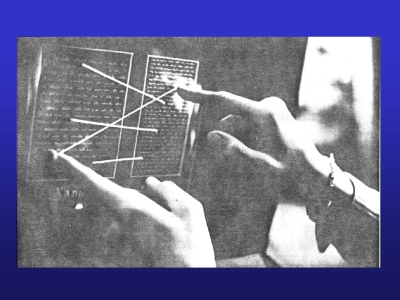 Fig. 1
Fig. 1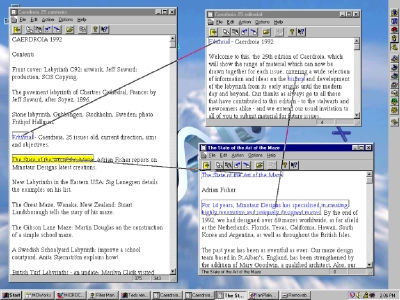 Fig. 2
Fig. 2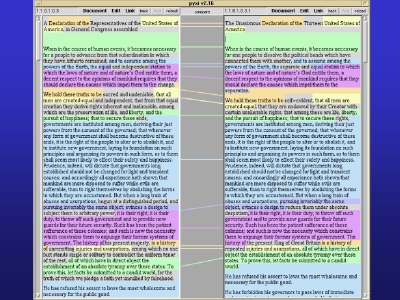 Fig. 3
Fig. 3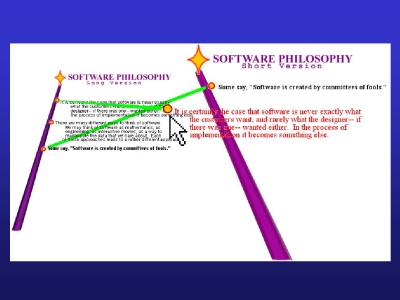 Fig. 4
Fig. 4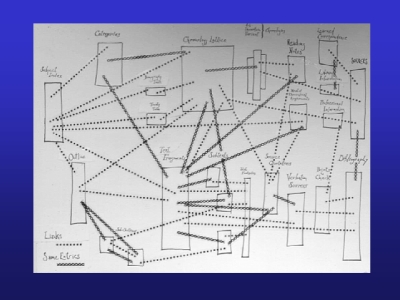 Fig. 5
Fig. 5